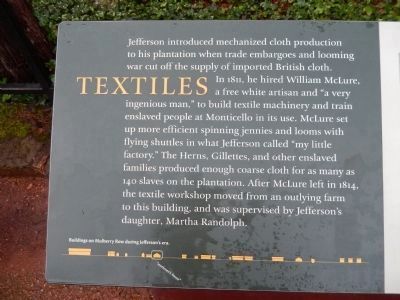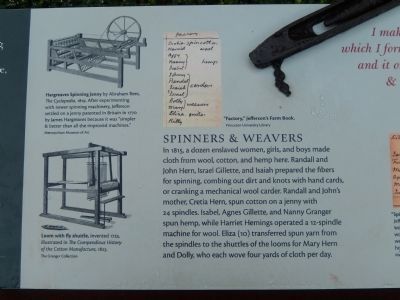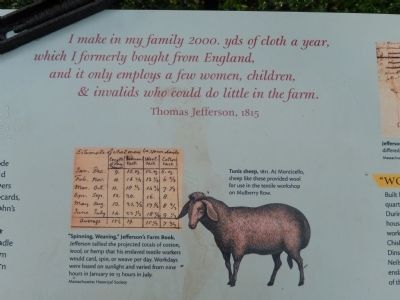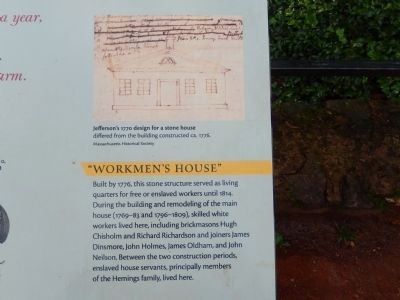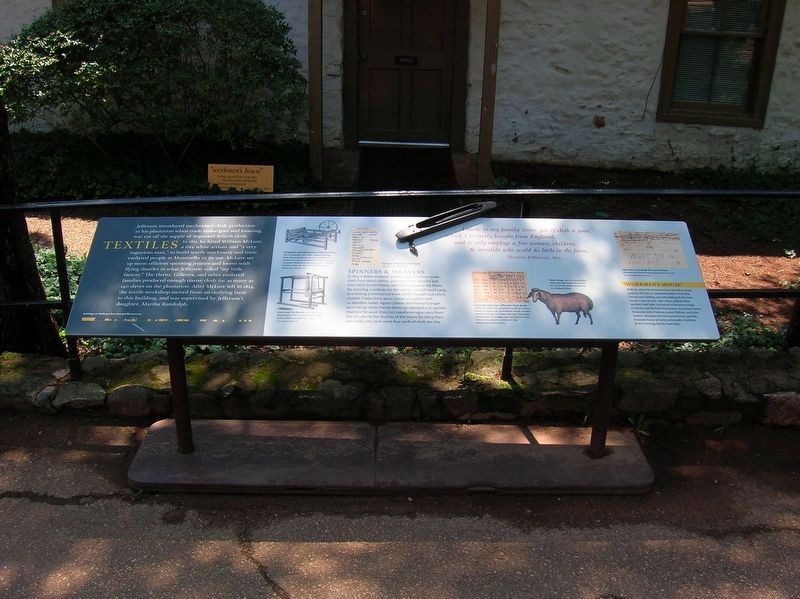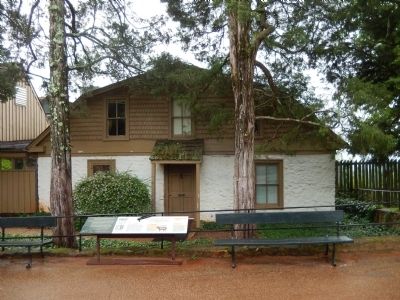Near Charlottesville in Albemarle County, Virginia — The American South (Mid-Atlantic)
Textiles
— Thomas Jefferson's Monticello —
Panel 1
Jefferson introduced mechanized cloth production to his plantation when trade embargoes and looming war cut off the supply of imported British cloth. In 1811, he hired William McLure, a free white artisan and "a very ingenious man," to build textile machinery and train enslaved people at Monticello in its use. McLure set up more efficient spinning jennies and looms with flying shuttles in what Jefferson called "my little factory." the Herns, Gillettes, and other enslaved families produced enough coarse cloth for as many as 140 slaves on the plantation. After McLure left in 1814, the textile workshop moved from an outlying farm to this building, and was supervised by Jefferson's daughter, Martha Randolph.
Panel 2
Spinners & Weavers
In 1815, a dozen enslaved women, girls, and boys made cloth from wool, cotton, and hemp here. Randall and John Hern, Israel Gillette, and Isaiah prepared the fibers for spinning, combing out dirt and knots with hand cards, or cranking a mechanical wood carder. Randall and John's mother, Cretia Hern, spun cotton on a jenny with 24 spindles. Isabel, Agnes Gillette, and Nanny Granger spun hemp, while Harriet Hemings operated a 12-spindle machine for wool. Eliza (10) transferred spun yarn from the spindles to the shuttles of the looms for Mary Hern and Dolly, who each wove four yards of cloth per day.
Hargreaves Spinning Jenny by Abraham Rees, The Cyclopedia, in 1819. after experimenting with newer spinning machinery, Jefferson settled on a jenny patented in Britain in 1770 by James Hargreaves because it was "simpler & better than all the improved machines."
Loom with fly shuttle, invented 1733, illustrated in The Compendious History of the Cotton Manufacture, 1823.
Panel 3
I make in my family 2000 yds. of cloth a year, which I formerly bought from England, and it only employs a few women, children & invalids who could do little in the farm.
Thomas Jefferson, 1815
"Spinning,Weaving," Jefferson's Farm Book.
Jefferson tallied the projected totals of cotton wool, or hemp that his ensalved textile workers would card, spin, or weave per day. Workdays were based on sunlight and varied from nine hours in January to 13 hours in July.
Tunis sheep 1811, At Monticello, sheep like these provided wool for use in the textile workshop on Mulberry Row.
Panel 4
"Workmen's House"
Built in 1776, this stone structure served as living quarters for free or enslaved workers until 1814. During the building and remodeling of the main house (1769-83 and 1796-1809), skilled white workers lived here, including brickmasons Hugh Chisholm and Richard Richardson and joiners James Dinsmore, John Holmes, James Oldham, and John Nilson. Between the two construction periods, enslaved house servants, principally members of the Hemings family, lived here.
Jefferson's 1770 design for a stone house differed from the building constructed ca. 1776.
Topics and series. This historical marker is listed in these topic lists: African Americans • Industry & Commerce. In addition, it is included in the Former U.S. Presidents: #03 Thomas Jefferson series list. A significant historical year for this entry is 1811.
Location. 38° 0.584′ N, 78° 27.105′ W. Marker is near Charlottesville, Virginia, in Albemarle County. Marker can be reached from Thomas Jefferson Parkway. Marker is on the grounds of Monticello and an entrance fee is required. Touch for map. Marker is at or near this postal address: 995 Monticello Loop, Charlottesville VA 22902, United States of America. Touch for directions.
Other nearby markers. At least 8 other markers are within walking distance of this marker. Vegetable Garden (a few steps from this marker); Mulberry Row (within shouting distance of this marker); a different marker also named Mulberry Row (within shouting distance of this marker); Sally Hemings (within shouting distance of this marker); Sally Hemings's Life (within shouting distance of this marker); A Presidential Scandal: (within shouting distance of this marker); Slave Housing (within shouting distance of this marker); Making Monticello (within shouting distance of this marker). Touch for a list and map of all markers in Charlottesville.
Also see . . . Mulberry Row Reassessment. Thomas Jefferson's Monticello website entry (Submitted on January 18, 2023, by Larry Gertner of New York, New York.)
Credits. This page was last revised on February 2, 2023. It was originally submitted on August 28, 2013, by Bill Pfingsten of Bel Air, Maryland. This page has been viewed 1,121 times since then and 23 times this year. Photos: 1, 2, 3, 4. submitted on August 28, 2013, by Bill Pfingsten of Bel Air, Maryland. 5. submitted on December 4, 2016, by Michael C. Wilcox of Winston-Salem, North Carolina. 6. submitted on August 28, 2013, by Bill Pfingsten of Bel Air, Maryland.
